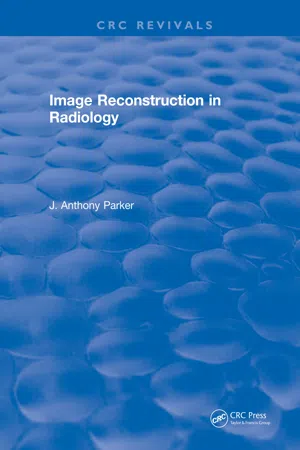This book is divided into four parts — System Models, Transformations, Filtering, and Reconstruction. The object of the first three parts of the book is to provide a background for Part IV which explains image reconstruction. However, the methods described in the first three parts are useful in themselves for understanding several aspects of radiology. Throughout the book, an attempt will be made to show how the mathematical methods apply to radiological problems.
We assume that the reader has taken a college calculus course. However, since some of the mathematics may be only dimly remembered, Chapter 2 provides a brief review of the calculus which will be used in the rest of the book. Other mathematical background material, necessary to understand reconstruction, is described in greater detail — complex numbers in Chapter 6, vectors and matrices in Chapters 8 and 9, and statistics in Chapters 10, 11, and 12.
A. Part I. System Models
Part I, System Models, deals with the various models which can be used to describe a system. The concept of a system is central to this book. Anytime one signal depends upon another signal, the relationship can be modeled as a system. The system is said to transform one signal, the input signal, into the other signal, the output signal. For example, the set of attenuation coefficients in a cross section of the body could be an input signal. The system could be a computed tomographic scanner. The output signal would then be the computed tomographic image.
Part I will explain the concept of a system by developing several different models of systems. The major models are convolution, simultaneous linear equations, and stochastic processes (noisy signals). In addition, differential equations are briefly mentioned in order to explain the idea of resonant signals.
Convolution is a method of describing simple linear systems. Convolution and Fourier transforms come from the field called linear systems theory. Chapters 3, 4, 5 and 6 deal with linear systems theory. Simultaneous linear equations provide a second method of describing linear systems. Simultaneous linear equations come from the field called linear algebra. Chapters 8 and 9 deal with linear algebra. We shall learn that a major feature of both of these models is that they assume that a system is linear.
For both convolution and simultaneous linear equations, we shall learn that there are special signals, called eigenfunctions, which do not change form as they pass through a system. These signals are described in Chapter 5. The concept of eigenfunction is often described in more complicated mathematical texts. We shall try to show that the basic concept of an eigenfunction is quite simple and will help in understanding how systems effect signals. Furthermore, in Part II, we shall find that eigenfunctions provide insights into the operation of the Fourier transform.
Complex numbers greatly simplify the description of linear systems and of the Fourier transform. Most readers either will have never heard of complex numbers or will have only a superficial acquaintance with complex numbers. In Chapter 6 we shall try to familiarize the reader with complex numbers. Although learning about complex numbers requires some mental anguish, the reward will be that much of the rest of the book will be considerably simplified.
Both convolution and simultaneous linear equations need to be combined with the idea of measurement noise in order to be useful for radiological applications. Chapter 10 introduces some basic statistical methods. Chapter 11 introduces statistical signals (stochastic processes). In Part IV, stochastic processes will be used to model both noisy measurements and reconstructed images.
Chapter 12 introduces the idea of estimation from a set of noisy measurements. Part III will combine the concept of a signals with estimation. Estimation i...
